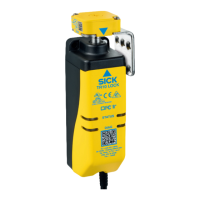b
Open the protective device and close it again. The components of the safety
locking device must not collide with other parts. When the protective device is
closed, the actuator must be in a position which enables the lock to be actuated.
Electrical functional test
1. Switch on the supply voltage.
2. Close all protective devices and activate the locks. The machine must not start up
on its own.
3. Check the lock. It must not be possible to open the protective device.
4. Start the machine function.
5. Make sure that the lock cannot be deactivated as long as the dangerous machine
function is active.
6. Stop the machine function and deactivate the lock.
7. Check whether the protective device is kept locked until there is no more risk of
injury (e.g., due to run-on movements).
8. Check the restart interlock. The machine function must not start while the lock is
deactivated.
9. Repeat steps 3 to 8 individually for each protective device.
NOTE
In the case of the “power to lock” version, an active locking command can be simulated
by applying a 24VDC voltage at the “lock input” contact.
7 COMMISSIONING
30
O P E R A T I N G I N S T R U C T I O N S | TR10 Lock 8019972/1CS1/2022-07-20 | SICK
Subject to change without notice

